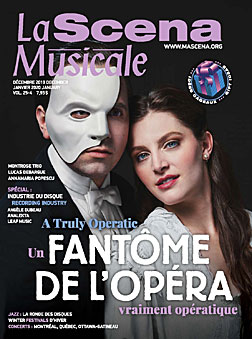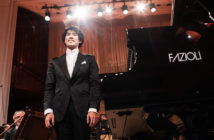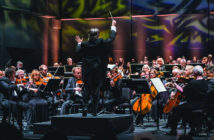
This page is also available in / Cette page est également disponible en:
Français (French)
NEW YORK – It is possible to lose a sense of perspective after a good night of Bruckner. The critic in me urges caution. Best live Fourth Symphony I have heard in months! My heart suggests something a little less guarded. Best in…well, quite a while. Certainly the performance ranks among the signal achievements in the history of the Orchestre Métropolitain, which on Friday made its third stop on a four-city U.S. tour and, not incidentally, its debut at Carnegie Hall.
You can imagine a new punch line to the old gag about how you get there: by having Yannick Nézet-Séguin as your artistic director and chief conductor for life. But an orchestra cannot expect YNS to sign a long-term contract without the latent ability to produce this kind of Fourth. What kind? Above all, flowing. This was not a start-and-stop performance but a continuous unfolding of Bruckner’s poetic rhetoric that led with wonderful integrity to his visionary ends.
Lyrical and Spontaneous
Worry not, climaxes had Brucknerian force and sustained brass chorales had Brucknerian cohesion. No less Brucknerian, however – and considerably less common – were the quiet passages in which one deep thought followed another. I think of the subdued closing of the exposition of the first movement and the shadowy entanglements of strings and winds that follow. Such formal connections scarcely seemed connections at all, so natural was the progression.
Yannick used all means at his disposal, signalling the slightest adjustments of dynamics and tempo and getting exact results. And sonority. Cellos and violas in the slow movement seemed all the more songful for not “digging in” to their tunes too aggressively. Horns were properly jubilant in the Scherzo (at a vigorous tempo) and the pizzicati were spot-on. The crescendo that begins the finale was contoured for maximum clarity, and therefore excitement. This wide-ranging movement inevitably sounds more like a blueprint than the others, but there were many individual beauties and the coda built steadily to an impressive conclusion – with a surprising hairpin decrescendo at the very end. It was all a remarkable demonstration of how a well-rehearsed orchestra (which, of course, has recorded this symphony as part of the Bruckner cycle on ATMA) can sound lyrical and spontaneous. And how it can transcend an understated treatment of the opening string tremolo from which the solo horn (Louis-Philippe Marsolais) emerges. This was a little too close to silence, at least from my seat.
How to complement a Bruckner symphony (except in the case of the Eighth, which is long enough to do without a “first half”) is an interesting problem. The creative and crowd-friendly solution on this tour is to have the stellar mezzo-soprano Joyce DiDonato (a YNS colleague even before the conductor’s elevation to the post of music director of the Metropolitan Opera) sing a pair of arias (“Parto, Parto” and “Non più di fiori”) from Mozart’s La Clemenza di Tito.
Both were delivered with bold sonority, articulatory force and plenty of old-fashioned stage presence. It was hard to say which character – Sesto or his beloved Vitellia – was tougher. (Maybe Vitellia.) Happily, DiDonato gave “Voi che sapate” from The Marriage of Figaro as an encore, introducing an element of charm that clearly delighted the crowd. The conductor did his bit with some good-natured podium hamming. Simon Aldrich played the prominent clarinet and basset horn parts from the front of the stage, on the right of the conductor (DiDonato, of course, was on his left). Interesting idea, but I think woodwind obbligatos sound better when they originate in the midst of the ensemble.
Fitting Epilogue
The arias followed a scrappy performance of the Clemenza overture. There was also an encore after the Bruckner, affectionately introduced by Nézet-Séguin from the podium: the resonantly modal closing pages of Violet Archer’s Poem of 1940. It is difficult for an orchestra to convince international presenters to accept a Canadian piece. Credit YNS for sneaking this in. It was both a fitting epilogue and a great showcase for the OM strings. The crowd was fortified with Canadian friends of the OM. Bruckner ended with the mandatory interlude of stunned silence before strong applause broke out, punctuated by hearty bravos. The people were undoubtedly responding not only to wonderful sounds but good views of Yannick. This is a conductor whose expressive podium style makes a positive impression on musicians and spectators alike.
The people were undoubtedly responding not only to wonderful sounds but good views of Yannick. This is a conductor whose expressive podium style makes a positive impression on musicians and spectators alike.
Finale in Philadelphia
My thanks to Jean Dupré for his handy four-word review of the tour finale in Philadelphia on the afternoon of Nov. 24.
“We did it again,” the OM president and CEO said outside Verizon Hall, home of the Philadelphia Orchestra (music director: Yannick Nézet-Séguin).
Indeed they did. In Bruckner, we heard the same calibre of playing in a crisper acoustic space that made the score seem less a matter of blend than balance. One was startled anew at the focus of the strings at both ends of the dynamic spectrum, the sweetness of the woodwinds, the authority of the brass. It is natural to equate the principal horn with the lonely call at the opening of the symphony. Louis-Philippe Marsolais reminded us of the eloquence required of this player in the Andante.
Unlike the Carnegie crowd, the Philadelphians started applauding as soon as the last chord faded away. Cheers for everybody. A particularly big hoot for the fine timpanist, Julien Bélanger.
DiDonato sang with as much assurance and glowing tone as in New York but even more pathos. Probably because I was sitting further back in the hall, the obbligatos seemed better integrated into the soundscape. The overture was more together. Maybe “we did it again” sells Philadelphia a little short.
Sound Checks
The concert followed a rehearsal in which Nézet-Séguin not only coached the players on the sonic particulars of the space but introduced – after scaling the summits in Carnegie – new ideas and refinements. His paradoxical theory is that by using a pre-concert sound check creatively, he can make it seem less of a burden.
“I used to find this very, very tiring on a tour,” YNS said in a group interview before the concert. “That means I need an hour or more of ‘being Yannick’: energetic, trying to be efficient, listening, guiding. I used to hate this. I would see the [mundane]purpose and say, ‘this is tiring me so much.’
“But in a way you have to reflect on what you do with this [time]. Do you just get used to the sound and feel where you are on the stage? You should use this for specific ideas. To correct, and to get better, and to focus on something new.”
Also, in this case, to thank DiDonato openly for her participation. And congratulate her on being “one of the most fabulous human beings of our time.”
This page is also available in / Cette page est également disponible en:
Français (French)



















